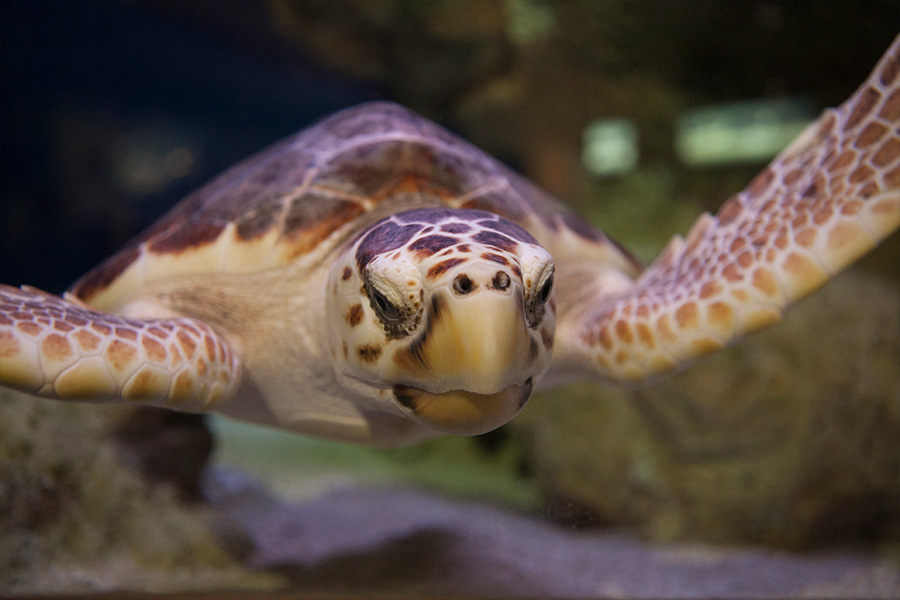
Habitat
Found in coastal bays and estuaries, and may also be found along the shallow waters of the continental shelf of the Atlantic.
Aquarium Location
Ocean
Fun Facts
- Have a very small brain and are opportunistic feeders (eat just about anything), so if they see a piece of trash like a plastic bag or a bottle in the ocean, it may look like a jellyfish or some other type of food to them. Eating this garbage is clearly not good for their stomach or their digestive system.
- Sea turtles do not have the ability to retract their head and flippers inside of their shell.
- The loggerhead sea turtle is the South Carolina state reptile (designated in 1988) and is the most commonly observed sea turtle off the SC coast.
- Loggerhead sea turtles have been classified as threatened since 1978, and are protected under the Endangered Species Act of 1973.
- Sea turtles have lived on the earth for about 150 million years, before the time of the dinosaurs.
Diet
Loggerhead sea turtles are, for the most part, carnivorous which means they mainly eat meat like crabs, clams, mussels, and other invertebrates. They can easily open the shellfish with their strong jaws. They also like to snack on animals such as slow moving jellyfish.
Cool Adaptation
Instead of having fleshy mouths with skin and soft lips (like humans) turtles have hard beaks, much like that of a bird. These beaks are made up of keratin, similar to our fingernails and lack the nerve endings and feeling that you would have in a fleshier mouth. This lack of sensitivity in its mouthparts only plays to a sea turtle’s advantage because loggerhead sea turtles love to prey on a variety of animals that species with a fleshy mouth could not prey upon. This includes a number of shelled animals such as crabs, clams, mussels and snails, which a loggerhead can simply crush with its strong jaws and hard beak. In addition, sea turtles love to prey on jellyfish, probably because of their abundance and slow swimming which makes them easy prey. Everyone knows that jellyfish have stinging cells (nematocysts) in their tentacles that can produce a painful sting to the skin of a human. For an animal with a beak though, this sting is not an issue because its beak lacks the nerve endings of regular skin and sea turtles can engulf large quantities of jellyfish as a result. Adapting beak-like mouthparts has allowed loggerhead sea turtles to survive in our oceans for millions of years by giving these slow swimming reptiles access to abundant, slow moving invertebrates as some of its major prey items.
Conservation Connection
Human impact on loggerhead sea turtles is causing a decrease in their numbers. Some adults are being killed by boat traffic, or drown in shrimp trawls or other nets. As a result of the pollution of our waterways, eggs have been found to contain harmful chemicals such as insecticides, which can hurt the egg and the developing embryo. Raccoons and other animals that prey on the sea turtle eggs have become more common in the last 30 years due to human development. The population of loggerhead sea turtles, as well as other species of sea turtles, is decreasing greatly due to the increased amount of development on our beaches. Clean, quiet, dark beaches are very important for sea turtle reproduction. Increased development has caused an increase in pollution, noise, and artificial lighting along our beaches, which disturbs nesting females as well as hatchlings trying to make their way to the sea. Efforts are being made to make people aware of these problems through “lights out for sea turtles” signs in beach communities, as well as groups of volunteers patrolling the beaches looking for nests, marking them and putting up fencing around them. The South Carolina Aquarium, also houses sick and injured sea turtles, nurses them back to health, and then releases them back into the wild.


